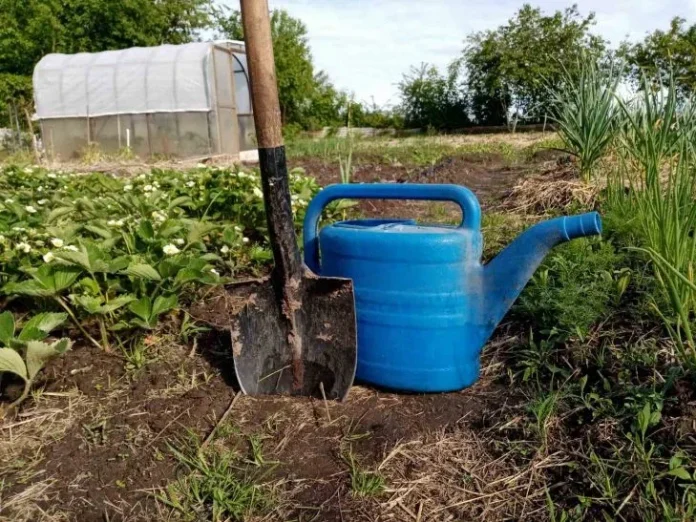Lytophthora is a real nightmare for any gardener. This fungal pathogen can destroy the entire crop in a matter of days..
Our magazine expert Anastasia Kovrizhnykh – a scientist agronomist, landscape designer, reminded summer residents of the most important thing.
Understanding the nature of late blight
Lytophthora belongs to the class of oomycetes and is a dangerous pathogen that affects various crops.
Tomatoes, potatoes and other nightshades are especially vulnerable to it.
The fungus spreads quickly in conditions of high humidity and moderate temperatures, which makes it especially dangerous during rainy seasons.
Preventive measures
Preventing the appearance of late blight is a key aspect in the fight against it.
Gardeners are advised to choose disease-resistant plant varieties and observe proper crop rotation.
It is also important to ensure good air circulation between plants, avoiding dense plantings.
Agrotechnical methods of control
To effectively get rid of late blight, it is necessary to use a set of agricultural measures.
Mulching the soil helps reduce the risk of infection by preventing leaves from coming into contact with contaminated soil.
Regular removal of the lower leaves of tomatoes and potatoes also helps reduce the likelihood of infection.
Biological means of protection
The use of biological products is becoming an increasingly popular method of combating late blight.
Lytophthora is a real nightmare for any gardener. This fungal pathogen can destroy the entire crop in a matter of days..
Our magazine expert Anastasia Kovrizhnykh – a scientist agronomist, landscape designer, reminded summer residents of the most important thing.
Understanding the nature of late blight
Lytophthora belongs to the class of oomycetes and is a dangerous pathogen that affects various crops.
Tomatoes, potatoes and other nightshades are especially vulnerable to it.
The fungus spreads quickly in conditions of high humidity and moderate temperatures, which makes it especially dangerous during rainy seasons.
Preventive measures
Preventing the appearance of late blight is a key aspect in the fight against it.
Gardeners are advised to choose disease-resistant plant varieties and observe proper crop rotation.
It is also important to ensure good air circulation between plants, avoiding dense plantings.
Agrotechnical methods of control
To effectively get rid of late blight, it is necessary to use a set of agricultural measures.
Mulching the soil helps reduce the risk of infection by preventing leaves from coming into contact with contaminated soil.
Regular removal of lower leaves from tomatoes and potatoes also helps reduce the likelihood of infection.
Biological means of protection
Lytophthora is a real nightmare for any gardener. This fungal pathogen can destroy the entire crop in a matter of days..
Our magazine expert Anastasia Kovrizhnykh – a scientist agronomist, landscape designer, reminded summer residents of the most important thing.
Understanding the nature of late blight
Lytophthora belongs to the class of oomycetes and is a dangerous pathogen that affects various crops.
Tomatoes, potatoes and other nightshades are especially vulnerable to it.
The fungus spreads quickly in conditions of high humidity and moderate temperatures, which makes it especially dangerous during rainy seasons.
Preventive measures
Preventing the appearance of late blight is a key aspect in the fight against it.
Gardeners are advised to choose disease-resistant plant varieties and observe proper crop rotation.
It is also important to ensure good air circulation between plants, avoiding dense plantings.
Agrotechnical methods of control
To effectively get rid of late blight, it is necessary to use a set of agricultural measures.
Mulching the soil helps reduce the risk of infection by preventing leaves from coming into contact with contaminated soil.
Regular removal of the lower leaves of tomatoes and potatoes also helps reduce the likelihood of infection.
Lytophthora is a real nightmare for any gardener. This fungal pathogen can destroy the entire crop in a matter of days..
Our magazine expert Anastasia Kovrizhnykh – a scientist agronomist, landscape designer, reminded summer residents of the most important thing.
Understanding the nature of late blight
Lytophthora belongs to the class of oomycetes and is a dangerous pathogen that affects various crops.
Tomatoes, potatoes and other nightshades are especially vulnerable to it.
The fungus spreads quickly in conditions of high humidity and moderate temperatures, which makes it especially dangerous during rainy seasons.
Preventive measures
Preventing the appearance of late blight is a key aspect in the fight against it.
Gardeners are advised to choose disease-resistant plant varieties and observe proper crop rotation.
Lytophthora is a real nightmare for any gardener. This fungal pathogen can destroy the entire crop in a matter of days..
Our magazine expert Anastasia Kovrizhnykh – a scientist agronomist, landscape designer, reminded summer residents of the most important thing.
Understanding the nature of late blight
Lytophthora belongs to the class of oomycetes and is a dangerous pathogen that affects various crops.
Tomatoes, potatoes and other nightshades are especially vulnerable to it.
The fungus spreads quickly in conditions of high humidity and moderate temperatures, which makes it especially dangerous during rainy seasons.
Lytophthora is a real nightmare for any gardener. This fungal pathogen can destroy the entire crop in a matter of days..
Our magazine expert Anastasia Kovrizhnykh – a scientist agronomist, landscape designer, reminded summer residents of the most important thing.
Understanding the nature of late blight
Lytophthora belongs to the class of oomycetes and is a dangerous pathogen that affects various crops.
Tomatoes, potatoes and other nightshades are especially vulnerable to it.
The fungus spreads quickly in conditions of high humidity and moderate temperatures, which makes it especially dangerous during rainy seasons.
Preventive measures
Preventing the appearance of late blight is a key aspect in the fight against it.
Gardeners are advised to choose disease-resistant plant varieties and observe proper crop rotation.
It is also important to ensure good air circulation between plants,avoiding dense plantings.
Agrotechnical control methods
To effectively get rid of late blight, it is necessary to use a set of agrotechnical measures.
Mulching the soil helps reduce the risk of infection by preventing contact of leaves with contaminated soil.
Regular removal of the lower leaves of tomatoes and potatoes also helps reduce the likelihood of infection.
Biological means of protection
Use of biological preparationsis becoming an increasingly popular method of combating late blight.
Trichodermin and phytosporin are examples of effective biological agents that suppress the development of the pathogen without harming the environment. These preparations contain beneficial microorganisms that compete with late blight for nutrients.
Chemical methods
In cases of severe infestation, the use of chemical fungicides may be required.
Copper-based preparations, such as Bordeaux mixture,have proven themselves well in the fight against late blight. However, it is important to remember the need to alternate preparations to prevent the development of pathogen resistance.
Folk remedies
Many gardeners successfully use folk methods of combating late blight. A solution of whey or garlic infusion can serve as an effective preventive measure.
Spraying plants with a weak solution of potassium permanganate also helps to strengthen their immunity and resist the disease.
Improving the soil structure
Healthy soil is the basis for plant resistance to diseases. The introduction of organic fertilizers, such as compost or humus, promotes the development of beneficial microflora, which naturally suppresses pathogens, including late blight.
Proper watering
Watering regime plays an important role in the prevention of late blight. Avoid over-wetting the soil and water getting on the leaves of plants.
DripIrrigation or watering under the root helps to minimize the risk of disease development.


